
|
November 14th, 2007
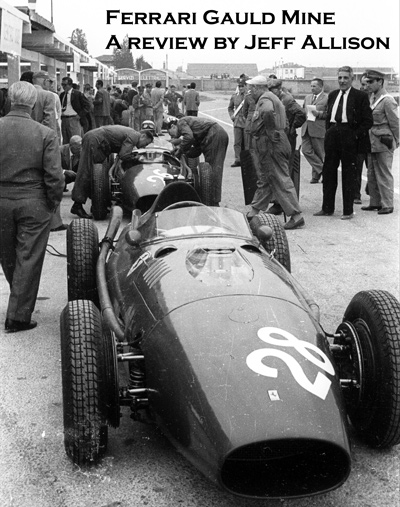
The Ferrari 246 F1 Dino grand prix cars debuted at the non-championship Modena Grand Prix on September 22, 1957. Here, the cars of Luigi Musso and Peter Collins (#28) await practice. Photo by Graham Gauld.
|
Ferrari Gauld Mine
A Compendium of Ferrari and Ferrari Related Stories
10.5� x 10.5� softbound
88 pages
Over 100 black and white images
First published in 2006
by Havelock Publishing in Great Britain
ISBN: 0-9549167-2-9
Available at around $40.00 from leading motoring bookshops or directly from
www.smrh.co.uk
First, a disclaimer as I know Graham Gauld professionally and as a friend and am an ardent admirer of his work. A further disclaimer is that I�m the editor of "Prancing Horse," the magazine of the Ferrari Club of America.
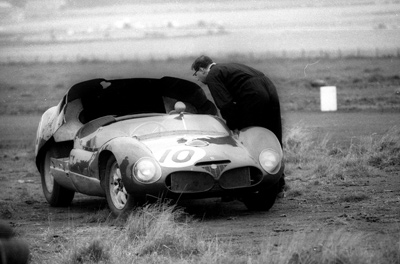
In the early 1960s, Englishman Phil Barak fitted a bored out 4 cylinder Ferrari 625 engine in a Cooper Monaco sports racing car. The nose of the Cooper was changed to mimic the split-nostril noses of the 1961-2 Ferrari sports racers. Photo by Graham Gauld.
|
Ferrari Gauld Mine�A compendium of Ferrari and Ferrari related stories is a collection of stories centering on Ferrari, called �Gauld Mines,� written by Graham Gauld for Prancing Horse magazine for the past 13 years. Graham is an unparalleled story teller�someone who was there, has first-hand, personal knowledge of what went on and one who is able to relate his special experiences in an engaging personal style that brings out the best of the subjects. In 1957, he went to Modena, Italy with a friend in an MGA coupe to visit Ferrari, Maserati, OSCA and Stanguellini as the 22-year sports editor of Motor World, a weekly motoring magazine published in Scotland. In Modena, he met Romolo Tavoni, Enzo Ferrari�s personal secretary and later team manager for Scuderia Ferrari, and Enzo Ferrari himself. Thus began his fascinating 50-year journey in cars and motor racing, frequently crossing paths with things Ferrari.
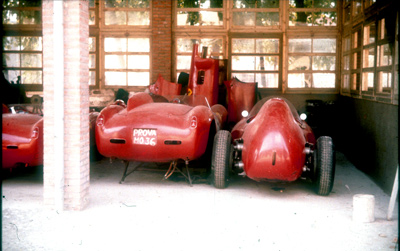
A sad sight indeed that brings tears to the eyes fo collectors and tifosi today as discarded sports racing and grand prix cars and many parts sit derelict in a concrete shed behind the factory in Maranello in 1958, waiting to go to the scrapyard. The car on the right is the 1958 Monza/Indianapolis Ferrari of Luigi Musso.
|
Gauld�s easy-reading style brings the characters and cars of Ferrari alive. The stories are vignettes about Enzo Ferrari, Ferrari�s drivers, engineers and mechanics, cars, collections and incidents centered on Ferrari. What makes the stories interesting is that Graham liked to look in unlikely places for interesting things. As he states, �It has always been my contention that we gain our knowledge�through the little anecdotes, and it is those little things which add flavor to a story.� An example is a story of the �most fascinating treasure trove� that Graham found behind the factory in a concrete shed in Maranello in 1958. His priceless and rare photograph of complete sports racing and grand prix Ferraris as �junk� tells the story without a word.
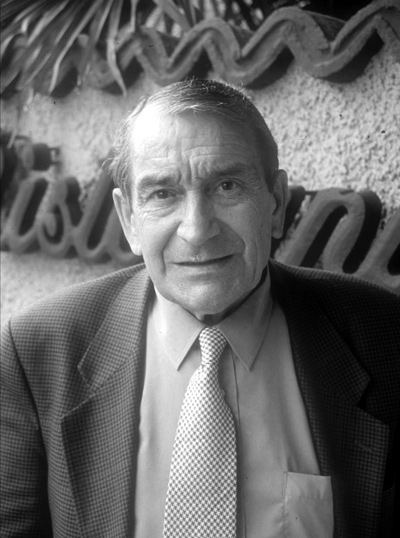
Franco Lini, photographed here by Gauld outside the Cavallino Restaurant in Maranello, was a working journalist who became the racing team manager in 1967. Photo by Graham Gauld.
|
Gauld irreverently tells some outrageous stories, such as a Morgan fitted with a body �cobbled up� in England from photographs and intended to look like a 1951 Inter Touring coupe, a Cooper Monaco sports racing car fitted with a Ferrari four-cylinder engine, a hydroplane with a twin-supercharged 4.5-liter 375 F1 engine and the �Carma,� a 308 look-alike built to compete in the 1981 Group C1 class of the World Sports Car Championship. Two feature articles included from PH are �Remembering Henry,� the quirky Road & Track scribe Henry Manney, and �Lord Selsdon: The Other Half of Luigi Chinetti�s 1949 Le Mans Win.�
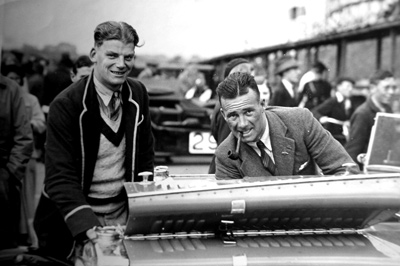
Little known and certainly forgotten over time was Lord Selsdon (left), who c-drove with Luigi Chinetti Sr. in a Ferrari 166MM (0008M) to win the 1949 Le Mans 24 Hours. Peter Mitchell-Thompson is pictured here at Brooklands before becoming the second Lord Selsdon, which his mechanic tending to his "chain gang" Frazer- Nash. Photo credit" Selsdon Archive.
|
Graham�s rubbed shoulders, talked with, written about and photographed many of the people involved with Ferrari including many he writes about in the book, such as driver Andrea de Adamich, Enzo Ferrari, driver Giancarlo Baghetti, journalist Henry Manney, owner and driver David McKay, journalist and team manager Franco Lini, owner and driver David Piper, Sergio Scaglietti, the aforementioned Tavoni, collector Albert Uderzo (creator of comic character Ast�rix the Gaul), collector and driver Fabrizio Violati and drivers Luigi Villoresi and Jonathan Williams. Some of the stories are about cars, such as Olivier Gendebien�s Tour de France winning 250 GT LWB berlinetta (0677 GT), the late Gil Nickel�s 500 Superfast (8019 SF), the Ecurie Ecosse F2 (125/10 C), factory testing of 335 S (0674), 250 GT LWB berlinetta 0899 GT and Dino 206 S (0834).
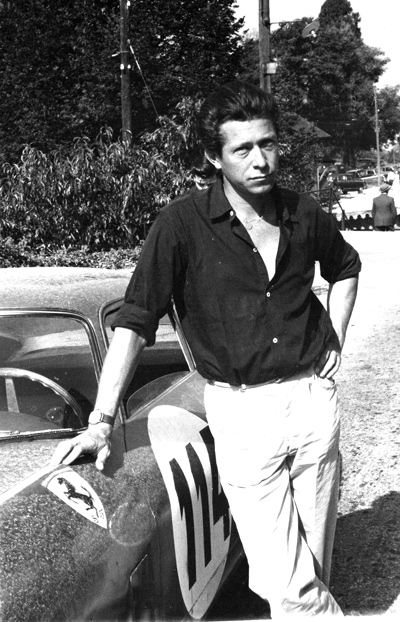
Belgian Olivier Gendebien leans on the Ferrari 250GT (0677 GT) he drove to many successes, including a win in the 1957 Tour de France. Photo by Graham Gauld.
|
There are some great quotes, such as when Jackie Stewart met with Enzo Ferrari to discuss the possibility of driving for Ferrari in 1968. Stewart took the initiative and mentioned he had talked to his lawyer. Enzo Ferrari turned to Lini and said, �He talks to his lawyer before he talks to me!� Graham provides insight to Enzo Ferrari in several of the stories, including �Defining the Enigma,� where he wrote: �On one occasion, when I casually remarked that now that he was going to use the V-6 Dino engine in a road car, he could get rid of ��that old V-12,� he reacted immediately. Gathering the few papers he had on his desk, he stood up, fixed me with those part hidden eyes [sunglasses] and said, �As long as I live, Ferrari will always have a V-12� and walked out of the room. Interview over!�
Once you pick this book up, it�s hard to put it down. Gauld�s photographs, which provide the perfect accent to each story, are worth the price of the book alone. He went to great lengths and worked hard for his photographs (sometimes at some risk to his health and welfare). For example, he once borrowed a tiny 125-cc Heinkel Bubble Car to drive from Edinburgh to Italy into the Alps to photograph the action at the Ollon-Villars event in the European Hill Climb Championship. One of my favorite photographs is the surplus WW II German searchlight trailer Jacques Swaters� Ecurie Francorchamps team used to haul their racers. Gauld�s 1958 photo shows a now coveted 250 TR (0736 TR) sitting on the trailer�s scruffy wooden planks held only by a large wooden chock and chains. There are many more like this one in Ferrari Gauld Mine!
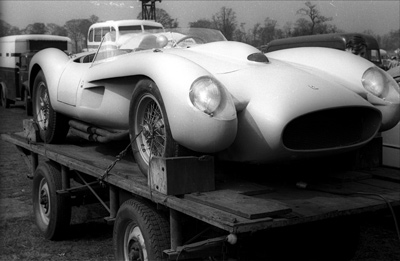
Sitting on a surplus WWII German searchlight trailer is the Ecurie Francorchamps Ferrari 250 Testa Rossa (s/n 0736 TR). Photo by Graham Gauld.
|
I unabashedly recommend the book as a valuable addition to the shelves of any car or motor racing fan and aficionado. Gauld Mine is obviously a play on �Gold Mine.� The book is full of gold nuggets that help to explain and capture the history and heritage of Ferrari. It�s certainly a must for the Ferrarista, but it�s also pertinent to the larger body of cars and motor racing history to be enjoyed by all.
Jeff Allison has been writing and photographing vintage sports cars and racing events since 1976. He�s served in editorial positions for "MG Abingdon Classics" and "Vintage Motorsport" and now serves as the editor of "Prancing Horse", the magazine of the Ferrari Club of America.
This book review was reprinted with the permission of Prancing Horse.
|

|



